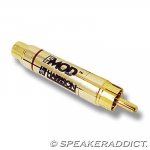I soldered together a few 100v bipolar capacitors in parallel to get 1590uF for a 25hz first order HP. For my HT sub builds it was more than adequate.
Capacitor in series behave different than parallel ( to ground)
Same for line level Vs power
That plug should contain a R-C net
Highpass is C-R
Search for PLLXO
Same for line level Vs power
That plug should contain a R-C net
Highpass is C-R
Search for PLLXO
RE: Low Pass inline Filter. This is what I am doing this sub is for a computer sound system, 2.1 the sub is a 5 1/4 in. driver driven temporarily with a 70 watt mono block amp. I would like to cut this off at 100hz. I am familiar with the parts you have mentioned (caps) but as to the application you describe and the abbreviated terms I am a bit fuzzy, Since a picture is worth a thousand words can you sketch this out or refer me to a visual reference perhaps.
Thanks
Thanks
Passive - only passive components
Line Level - it works with Voltage ( low...from 0.1 to 2 V )
X-Over - abbreviation for cross (X ) over
On the other side there's the active version
Operational amplifiers need a power supply, but they bring some advantages
And they perform much better than a passive filter where a steep slope is required, because 6/12 dB attenuation might not be sufficient.
Search also for some DS ( datasheet ) of some old op-amps such as TL 082
or TDA 2320A where there are some application circuits that might interest you.
for example for your purpose you need just a single dual Op-amp for performing mixing between L and R channels and a 18 dB/octave lowpass filter. And a single or dual power supply, of course, which may be derived from amplifier's PSU.
Line Level - it works with Voltage ( low...from 0.1 to 2 V )
X-Over - abbreviation for cross (X ) over
On the other side there's the active version
Operational amplifiers need a power supply, but they bring some advantages
And they perform much better than a passive filter where a steep slope is required, because 6/12 dB attenuation might not be sufficient.
Search also for some DS ( datasheet ) of some old op-amps such as TL 082
or TDA 2320A where there are some application circuits that might interest you.
for example for your purpose you need just a single dual Op-amp for performing mixing between L and R channels and a 18 dB/octave lowpass filter. And a single or dual power supply, of course, which may be derived from amplifier's PSU.
For a second order 12db/octave HP. From lets say 25hz you need a capacitor and a large coil around 38mh, such coils are hard to find and expensive.
With a first order 6db/octave only one cap, or multiple in parallel connected in series on the wire for the right uF value. It's is more then enough to protect a HT sub.
Whatever type you use, you need to calculate and see visually (graph) where the slope starts and where the effect of attenuation starts to make a difference for protecting the driver. So if your woofer starts to make mechanical noise at 30hz you probably need to hp at 45hz with a 6db slope or 40hz with a 12db slope
For even steeper slopes you really need to step up to active crossover in the form of an amp with DSP or add a mini-dsp to the chain.
With a first order 6db/octave only one cap, or multiple in parallel connected in series on the wire for the right uF value. It's is more then enough to protect a HT sub.
Whatever type you use, you need to calculate and see visually (graph) where the slope starts and where the effect of attenuation starts to make a difference for protecting the driver. So if your woofer starts to make mechanical noise at 30hz you probably need to hp at 45hz with a 6db slope or 40hz with a 12db slope
For even steeper slopes you really need to step up to active crossover in the form of an amp with DSP or add a mini-dsp to the chain.
I have an 80hz f-mod.
I saw it tested, it rolls at 6db an octave.
Can work well, especially without a loudness button or with a smaller speaker without bafflestep
I saw it tested, it rolls at 6db an octave.
Can work well, especially without a loudness button or with a smaller speaker without bafflestep
- Status
- Not open for further replies.
- Home
- Loudspeakers
- Subwoofers
- Low Pass inline Filter. Your opinion see pic.
